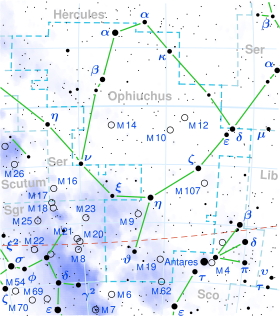Upsilon Ophiuchi
| Observation data Epoch J2000 Equinox J2000 | ||
|---|---|---|
| Constellation | Ophiuchus[1]
| |
| Right ascension | 16h 27m 48.17331s[2] | |
| Declination | −08° 22′ 18.4156″[2] | |
| Apparent magnitude (V) | 4.62[1] | |
| Characteristics | ||
| Spectral type | kA2hA5VmA5[3] | |
| U−B color index | +0.06[4] | |
| B−V color index | +0.16[4] | |
| Absolute magnitude (MV) | 1.75[1] | |
Semi-amplitude (K1)(primary) | 34.9±0.3 km/s | |
| Semi-amplitude (K2) (secondary) | 41.1±0.3 km/s | |
Argument of periastron (ω)(secondary) | 177.9±7.4° | |
| Details | ||
| Aa1 | ||
Myr | ||
| Ab1 | ||
Myr | ||
| Database references | ||
| SIMBAD | data | |
| Aa1 | |||||||||||
| Period = 27.s d | |||||||||||
| Ab2 | |||||||||||
| Period = 82.8 yr | |||||||||||
| Ab1 | |||||||||||
| Sep = 0.06 au | |||||||||||
| Ab2 | |||||||||||
Hierarchy of orbits[8]
Upsilon Ophiuchi is a
light years based on parallax. It is drifting closer with a radial velocity
of −30.6 km/s.
The variable radial velocity of the brighter component was first observed by
Am stars.[3] The fainter component has an 82.8 year orbit with the brighter pair at an eccentricity of 0.45,[7] and is itself binary, making the system a quadruple.[8] The system is a source for X-ray emission.[12]
This system forms part of the Upsilon Ophiuchi cluster, a small group of six stars which share similar kinematics and are spread over about eight degrees. The two brightest stars, apart from Upsilon Ophiuchi itself, are sometimes listed as components B and C: B is HD 148300, and C is HD 144660.[8] Both are 9th-magnitude K-class dwarfs.[13]
Notes
- ^ milliarcseconds) and a distance of 39.9 parsecs via the equation R/R☉ = (107.5 • 𝜃 • d)/1000, where 𝜃 is the angular diameter and d is the distance.
References
- ^ S2CID 119257644. Vizier catalog entry
- ^ S2CID 244398875. Gaia DR3 record for this source at VizieR.
- ^ doi:10.1086/192182.
- ^
- )
- ^ Bibcode:1965PDAO...12..391G.
- ^ a b "Sixth Catalog of Orbits of Visual Binary Stars". United States Naval Observatory. Archived from the original on 1 August 2017. Retrieved 24 May 2017.
- ^ ISSN 2515-5172.
- ^ S2CID 33401607. Vizier catalog entry
- Bibcode:1995yCat.5050....0H.
- ^ "ups Oph", SIMBAD, Centre de données astronomiques de Strasbourg, retrieved 2019-10-21.
- Bibcode:2001KFNT...17..409K.
